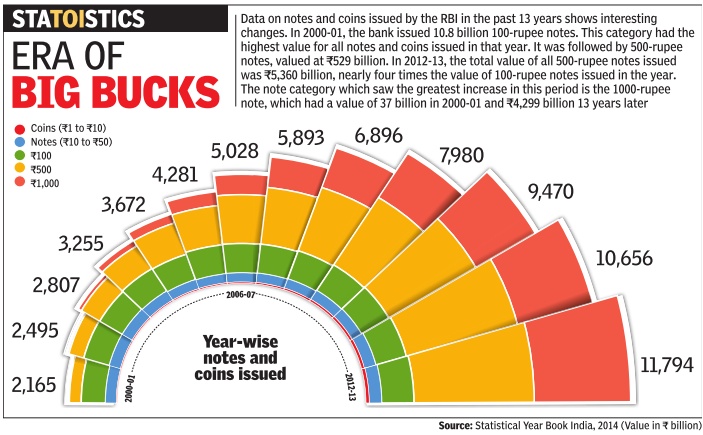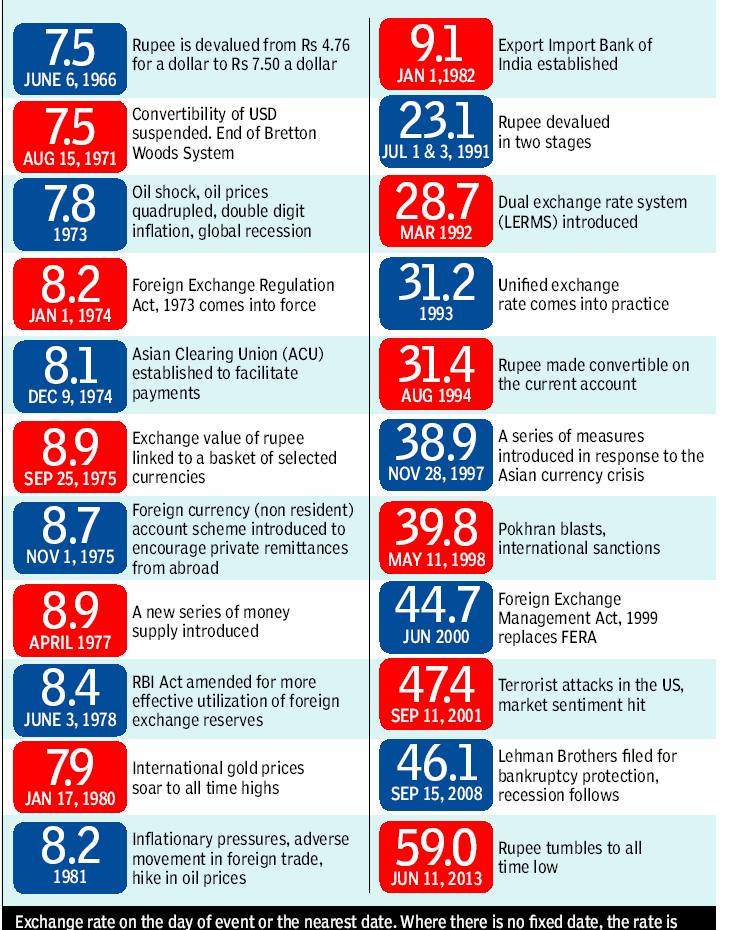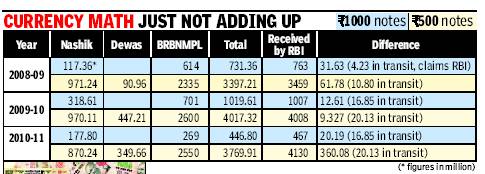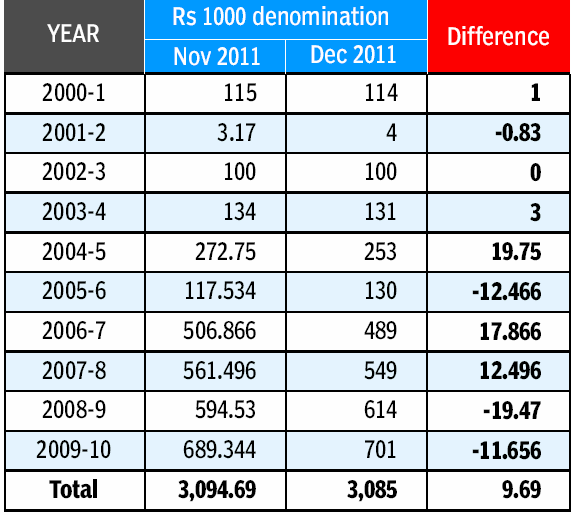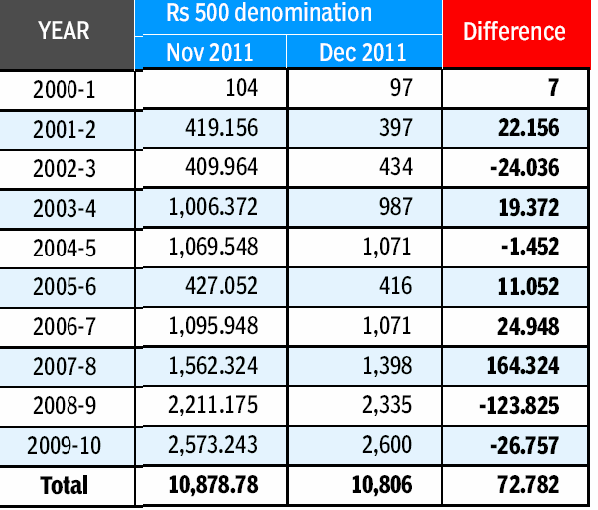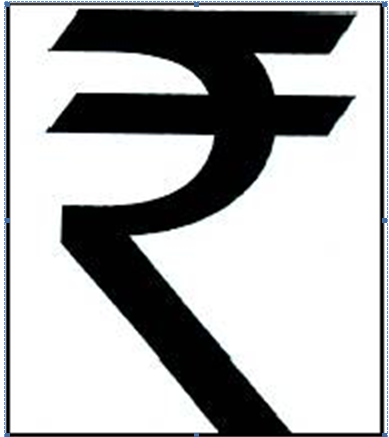Currency: India
(→Most counterfeited currency after US Dollar and Euro) |
(→In Switzerland: Most counterfeited currency after US Dollar and Euro) |
||
| Line 124: | Line 124: | ||
[[Category:Development|R]] | [[Category:Development|R]] | ||
[[Category:Government|R]] | [[Category:Government|R]] | ||
| + | |||
| + | [[File: currency.jpg| Chart: [http://epaperbeta.timesofindia.com/Gallery.aspx?id=21_08_2014_008_020_002&type=P&artUrl=STATOISTICS-21082014008020&eid=31808 The Times of India ] |frame|500px]] | ||
Revision as of 06:56, 21 November 2014
This is a collection of newspaper articles selected for the excellence of their content. |
Contents |
The steady depreciation of the rupee
See the accompanying chart
The Times of India 15 June 2013
See Table 1 below
Depreciation: 2000-13
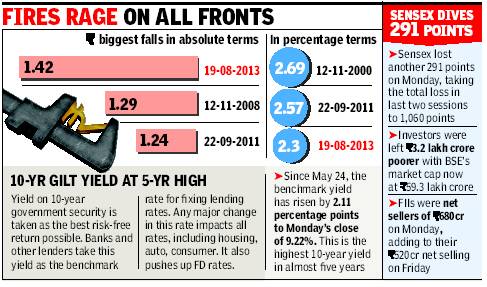
The rupee under various finance ministers
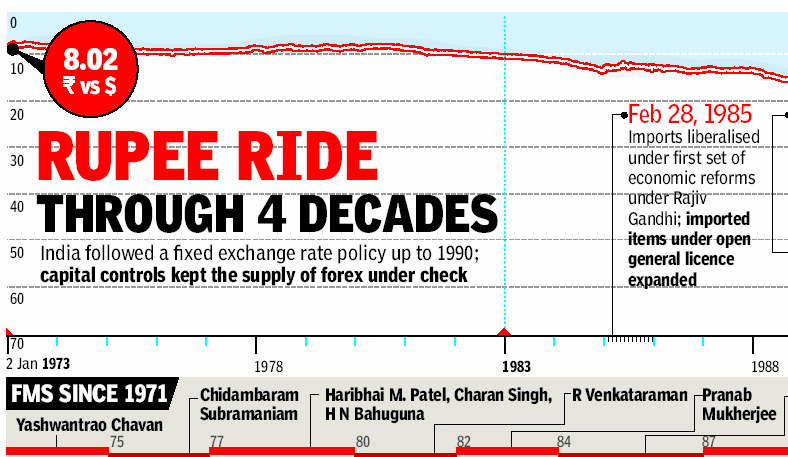
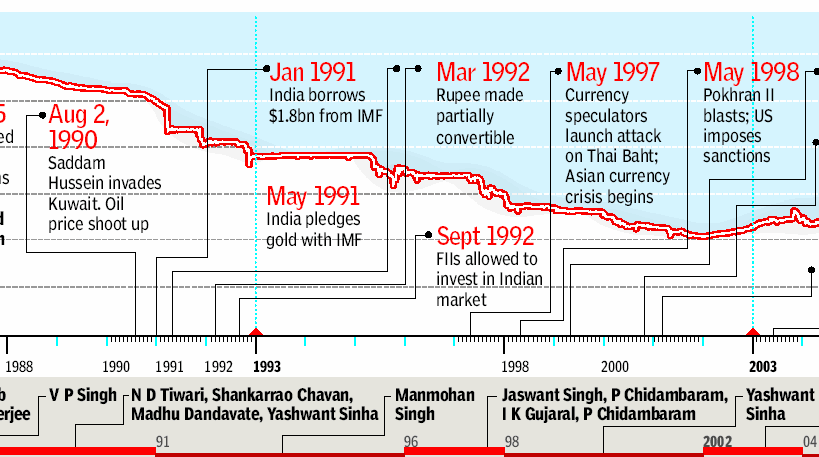
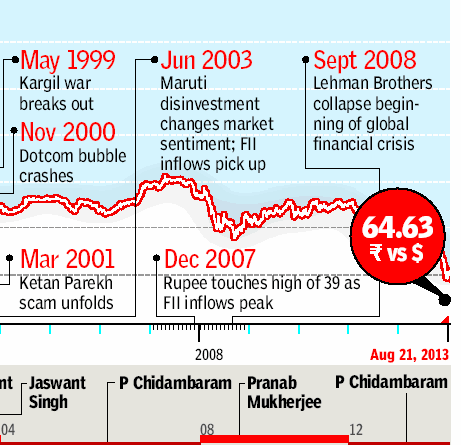
Unaccounted for rupees in circulation
Millions of notes not printed in mints land in RBI vaults
Bank, Press Records Don’t Tally
Hemali Chhapia TNN
The Times of India 2013/08/04
Mumbai: Millions of currency notes worth hundreds of crores of rupees that have apparently never been printed at our nation’s mints have mysteriously made it to the vaults of the Reserve Bank of India over the years.
A series of RTI applications reveal that while the mismatch between currency bills printed and those transported to the RBI is seen across denominations, it is more pronounced in the case of higher value notes — those of Rs 1,000 and Rs 500.
Take the Rs 1,000 notes. The redesigned bill was introduced in October 2000. Ever since, the two authorized mints — Bharatiya Reserve Bank Note Mudran Private Limited, Bangalore, and Currency Note Press, Nashik — have printed a total of 4,452.3 million bills. But RBI records show that it has received 4,462 million notes, an excess of 9.7 million notes. That means the RBI has received Rs 970 crore more than what was actually printed.
WHAT THE RBI SPOKESPERSON SAYS
You have collected the data of printing from the press and the supply received from RBI. You cannot do that because there are a lot of logistics involved. Numbers must be compared from the one source; either you take RBI numbers or the printing presses’ numbers. You cannot mix and match.
An aggregate discrepancy of Rs 4,608 crore
In 2006-07 the number of 1000-rupee notes received by the RBI was 589 million. (The number of such notes printed that year was 591m.)
While this closes the difference between what was printed and what was received to a considerable extent, there still remains a discrepancy of about Rs 72 crore for the period in question, which the bank has attributed to “rounding off”.
However, there is a large discrepancy between the numbers provided by the Bharatiya Reserve Bank Note Mudran, RBI’s wholly owned subsidiary, in its response to two similar queries just a month and a half apart under the Right to Information Act. A response dated November 10, 2011 to a query indicates the total count of Rs 500 notes printed between 2000-01 and 2009-10 as 10,878m while another response dated December 24, 2011 shows 10,806 m notes were printed—a difference of 72.782m notes valued at over Rs 3,639 crore (see Tables 3a-c).
Similarly, there is a difference in the case of currency notes of Rs 1000 denomination. The November response indicates the total number of Rs 1000 notes printed between 2000-01 and 2009-2010 as 3094.69m while the December response places it at 3,085m—a difference of 9.69m notes valued at Rs 969 crore (see Tables 3a-c).
The aggregate discrepancy—Rs 500 and Rs 1,000 notes—between the two RTI responses is a significant Rs 4,608 crore.
Rupee symbol
Rupee becomes only 5th currency to get a symbol Design By IIT Grad Cleared By Cabinet
New Delhi: In keeping with India’s growing economic might and its status as a major investment destination, the hitherto humble rupee is all set to get a distinct identity in the form of a new symbol. The Union Cabinet on Thursday gave its approval to the symbol which combines the Roman letter ‘R’ with the Devnagri ‘Ra’.
The symbol will catapult the rupee into the company of four ‘elite’ currencies which have similarly distinct identities — the US dollar, euro, yen and British pound.
The symbol has been designed by D Udaya Kumar, an IIT Bombay post-graduate, who has just joined as a teacher at IIT Guwahati. Kumar will receive a prize money of Rs 2.5 lakh for his efforts. The symbol will standardize the expression for the Indian rupee in different languages, both within and outside the country.
‘‘It’s a big statement on the Indian currency. It would distinguish the rupee from those countries whose currencies are also designated as rupee or rupiah, such as Pakistan, Nepal, Sri Lanka and Indonesia,’’ I&B minister Ambika Soni said after the Cabinet meeting. The symbol, she added, would reflect the strength and robustness of the Indian economy.
Till now, the Indian currency was simply denoted by Rs or INR. Kumar’s symbol was chosen after a public competition was held among resident Indian citizens inviting entries for a symbol which ‘‘reflects and captures the Indian ethos and culture’’.
Over 3,000 entries were received. These were evaluated by a jury headed by the RBI deputy governor, which included experts from reputed art and design institutes.
‘‘The entries were presented to the jury in such a manner that the identity of the competitors was not revealed to the jury members. The jury selected five final entries and also gave its evaluation of these five entries to the government to take a final decision,’’ said Soni. Re symbol to be adopted in 6 mths New Delhi: The new symbol for the rupee, cleared by Cabinet on Thursday, will not be printed or embossed on currency notes or coins, but it would be included in the ‘Unicode Standard’ and major scripts of the world to ensure that it is easily displayed and printed in the electronic and print media.
Unicode is an international standard that allows text data to be interchanged globally without conflict. After incorporation in the global and Indian codes, the symbol will be used by all individuals and entities within and outside the country.
The symbol will be adopted in a span of six months in the country, and within 18 to 24 months globally, Soni said, adding that it will feature on computer keyboards and software for worldwide use.
‘‘It is a perfect blend of Indian and Roman letters — capital ‘R’ and Devanagri ‘Ra’ which represents rupaiah — to appeal to international and Indian audiences. My design is based on the tricolour, with two lines at the top and white space in between,’’ Kumar told a news agency.
After encoding of the symbol in the Unicode Standard and National Standard, NASSCOM will approach software development companies for incorporating the rupee symbol in their operative software, as a new programme or as an update, to enable computer users worldwide to use the symbol even if it is not embedded on the keyboards (much like the way Euro symbol is used even though it is not embedded in the keyboards in use in India).
MAKING A MARK
The new symbol blends the Devnagri ‘Ra’ and Roman ‘R’. Its design is based on the tricolour, says creator D Udaya Kumar
In Switzerland: Most counterfeited currency after US Dollar and Euro
Rupee third on fake foreign currency list in Switzerland
The number of fake Indian rupee notes found in Switzerland during 2013 stood at 403 — the third highest for any foreign currency.
PTI | Jul 20, 2014
NEW DELHI/BERNE: As a debate continues on alleged black money of Indians in Swiss banks, the authorities in Switzerland have come across a significant quantum of fake Indian rupee notes in their country — the third highest for any foreign currency after Euro and the US dollar.
According to the latest counterfeit currency statistics released by Switzerland's Federal Office of Police (Fedpol), the number of fake Euro notes seized in the year 2013 stood at 2,394, while there were 1,101 fake US dollar bills.
The number of fake Indian rupee notes found in Switzerland during 2013 stood at 403 — the third highest for any foreign currency. This included 380 fake Rs 500 notes and another 23 counterfeit Rs 1,000 notes.
However, the numbers have declined considerably since 2012 when Fedpol found as many as 2,624 fake rupee notes — the second highest among foreign currencies after 5,284 counterfeit US dollar notes at that time. The number of fake Euro notes was third highest during that year at 2,084.
The number of fake Swiss franc notes stood at 4,309 during 2012, but was higher than any foreign currency in 2013 at 3,729, as per details compiled by the Fedpol's Counterfeit Currency Unit.
Among other counterfeit foreign currencies found during 2013, there were 99 fake British pound notes, 71 South African rand notes, 34 Deutsche Mark notes (German currency officially in circulation from 1948 till 2002 when Euro was introduced), 23 Chinese yuan notes and ten Canadian dollar.
The number of any other fake foreign currency notes was in single-digits.